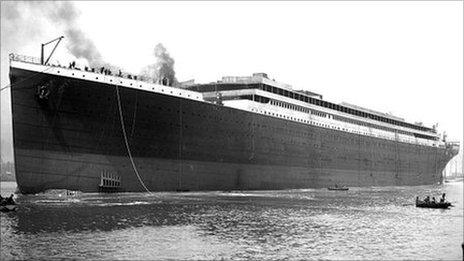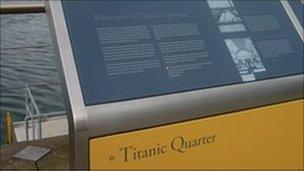Sinking was disaster but ship was engineering triumph
- Published

The Titanic when she was launched 100 years ago before her iconic four funnels were fitted
The Titanic is no longer a taboo topic in Belfast as the city marks 100 years since the luxury liner's launch.
Back in April 1912, there was a sense of embarrassment when the "unsinkable" ship hit an iceberg and went under.
Fast forward a century and Belfast is no longer hiding from its Titanic past.
The launch, maiden voyage and sinking of the ship will all be marked in the city which now boasts its own Titanic Quarter, full of residential and commercial ventures including a tourist trail.
"What happened to Titanic was a disaster but she was not," says Una Reilly, co-founder of the Belfast Titanic Society.
"It's amazing to think that we here, in this small corner of the then empire, made the biggest ship in the world."
"We have an awful lot to be proud of. We are not very good at blowing our own trumpets, but we are re-claiming that pride."
It was on 31 May 1911 that Titanic, held together by three million rivets, first entered the water.
Even though the famous four funnels were not yet in place, and none of the ornate furnishings had been completed, it was still quite a sight as the huge vessel entered Belfast Lough.
Crowds gathered to watch the launch, but the spectacle did not last long.
The Rev Chris Bennett, who helps conduct Titanic walking tours, says it took just over a minute for the ship to slide from land to sea - thanks to the appliance of industrial quantities of soap, grease and oil.
"The command was shouted to 'release the triggers' and it took just 62 seconds. A massive wall of riveted metal came scraping and screaming down the slipway into the sea," he said.
At the time, it was largest man-made moving object on earth. The floating hotel was built by Harland and Wolff whose workforce in 1911 was around 15,000-strong.

Belfast now boasts its own Titanic Quarter
One of the deck engineers, Thomas Millar, not only helped to build the ship, but sailed on her doomed maiden voyage from Southampton to New York. He was one of the 1,517 passengers and crew who died when she sank.
His great grand-daughter, Susan, now runs Titanic tours and has written a book about Thomas Millar.
"Belfast kept quiet about its Titanic connection for too long," she says.
"We can now start to share that story with the rest of the world. For so long, we didn't know how to deal with Titanic. We were a bit embarrassed about it, but now we have come to a place where we can celebrate it as an achievement.
"It was a beautiful ship and a beautiful piece of engineering."
Although the shipyard in east Belfast gained a reputation in the 20th Century as a bastion of Protestant unionism, recent research has shown that Catholics were also involved in the three-year construction project.
Una Reilly says: "The workforce was mixed. There were actually thousands of Catholics employed at the time. Of course, things changed afterwards, but at the time the Titanic was built by all of us."
She says Belfast was the "Cape Canaveral" of shipbuilding, with the very latest technology used to build the Titanic.
The problem was that no ship was unsinkable, and the fact that Titanic hit the iceberg side-on meant more of the vessel was damaged as she scraped along the iceberg than might have been the case in a head-on collision.
The Titanic did have a number of water-tight compartments - but not enough. The ship also had a chronic shortage of lifeboats for such an emergency.
A ship designed to accommodate 3,511 passengers and crew only had lifeboat capacity for 1,178 people. To make matters worse, some lifeboats were launched before being totally filled.
Nonetheless, there is no doubting that the ship was a remarkable feat of early 20th Century engineering.
When Belfast people are asked about the Titanic, they often remark "she was all right when she left us".
As the decades have passed since the disaster, the blame game over the Titanic has turned into a tourist trail.
Fuelled by the 1997 blockbuster movie Titanic, people from across the world have traced the ship's final movements from Belfast to Southampton to the Atlantic seabed, two miles below the surface.
Indeed, as the centenary of the sinking on 14 April 1912 approaches, the Titanic movie stars Kate Winslet and Leonardo DiCaprio are likely to be invited to take part in the anniversary events.
An invitation from Belfast is in the post already.
Follow Mark Simpson on Twitter: @BBCMarkSimpson
- Published15 April 2013